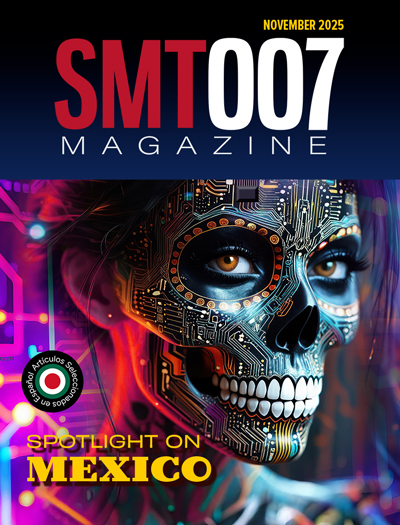-

-
News
News Highlights
- Books
Featured Books
- smt007 Magazine
Latest Issues
Current Issue
Spotlight on Mexico
Mexico isn’t just part of the electronics manufacturing conversation—it’s leading it. From growing investments to cross-border collaborations, Mexico is fast becoming the center of electronics in North America. This issue includes bilingual content, with all feature articles available in both English and Spanish.

Production Software Integration
EMS companies need advanced software systems to thrive and compete. But these systems require significant effort to integrate and deploy. What is the reality, and how can we make it easier for everyone?

Spotlight on India
We invite you on a virtual tour of India’s thriving ecosystem, guided by the Global Electronics Association’s India office staff, who share their insights into the region’s growth and opportunities.
- Articles
- Columns
- Links
- Media kit
||| MENU - smt007 Magazine
Estimated reading time: 1 minute
Tin Whiskers, Part 5: Impact of Testing Conditions
In this installment of the tin whisker series, we'll take a look at the impact of testing conditions, and follow-up with this statement from Part 4: “…all-encompassing tests to confirm or deny the culprits for tin whiskers are prohibitively costly and time-consuming…”
The JEDEC Solid State Technology Association (formerly known as the Joint Electron Device Engineering Council) has published several documents that address and/or are related to the testing of tin whiskers, which are good guidelines with which to start.
- JEDEC Standard No. 201: Environmental Acceptance requirements for Tin Whisker Susceptibility of Tin and Tin Alloy Surface Finishes.
- JEDEC Standard No. 22A12: Measuring Whisker Growth on Tin and Tin Alloy Surface Finishes.
- JEDEC Standard No. 22-A104D: Temperature Cycling.
Primarily, three sets of testing conditions are included in the JEDEC documents: ambient temperature storage, elevated temperature storage and temperature cycling, with the following parameters:
Room Temperature Humidity Storage
30 ± 2°C and 60 ± 3% RH
(1,000 hrs interval inspection/3,000 to 4,000 hours total duration)
Temperature Humidity Unbiased
60 ± 5°C and 87 + 3/-2% RH
(1,000 hours interval inspection/3,000 to 4,000 hours total duration)
Temperature Cycling
Lower end temperature: -55 to -40 (+0/-10)°C
Higher end temperature: +85 (+10/-0)°C
(500 cycles inspection /1,000 to 1,500 cycles duration/air to air/5 to 10 minute soak/three cycles per hour)
Read the full column here.
Editor's Note: This column originally appeared in the May 2014 issue of SMT Magazine.
More Columns from SMT Perspectives and Prospects
SMT Perspectives & Prospects: Artificial Intelligence Part 6: Data Module 1SMT Perspectives and Prospects: Warren Buffett’s Perpetual Wisdom, Part 2
SMT Perspectives and Prospects: Warren Buffett’s Perpetual Wisdom, Part 1
SMT Perspectives and Prospects: Artificial Intelligence, Part 5: Brain, Mind, Intelligence
SMT Perspectives and Prospects: Artificial Intelligence, Part 4—Prompt Engineering
SMT Perspectives and Prospects: The AI Era, Part 3: LLMs, SLMs, and Foundation Models
SMT Perspectives and Prospects: A Dose of Wisdom
SMT Prospects and Perspectives: AI Opportunities, Challenges, and Possibilities, Part 1


